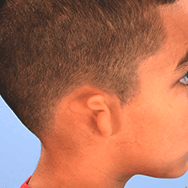Microtia-ear-anomalies

Microtia is a congenital abnormality in which the external part of a child’s ear is underdeveloped and usually malformed. The defect can affect one (unilateral) or both (bilateral) ears. In about 90 percent of cases, it occurs unilaterally.
Microtia. Microtia means “small ear.” Most children with microtia have a normally formed inner ear but lack all or part of the structures that form the outer ear, including the opening in some cases. This condition can occur on one or both sides of the head. Without the external structures to funnel sound to the inner ear, children often have difficulty hearing and determining the direction of the sound. In some cases, a child with microtia has no hearing in the affected ear because of the absence of the external ear canal. This is called aural atresia. Some children with aural atresia require a hearing aid. Children with aural atresia typically also have the incomplete formation of the small middle ear bones and may lack an eardrum. Microtia can also occur along with other facial anomalies such as oculo auricula vertebral spectrum disorders.
Surgery is the typical treatment for ear anomalies. Surgical procedures are based on the type of anomaly being treated:
Microtia Surgeries to treat microtia can be performed depending on the surgeon’s preferred technique, one stage or multiple stages of surgery may be needed. Ear reconstruction can be based on a cartilaginous framework (multiple stages).
